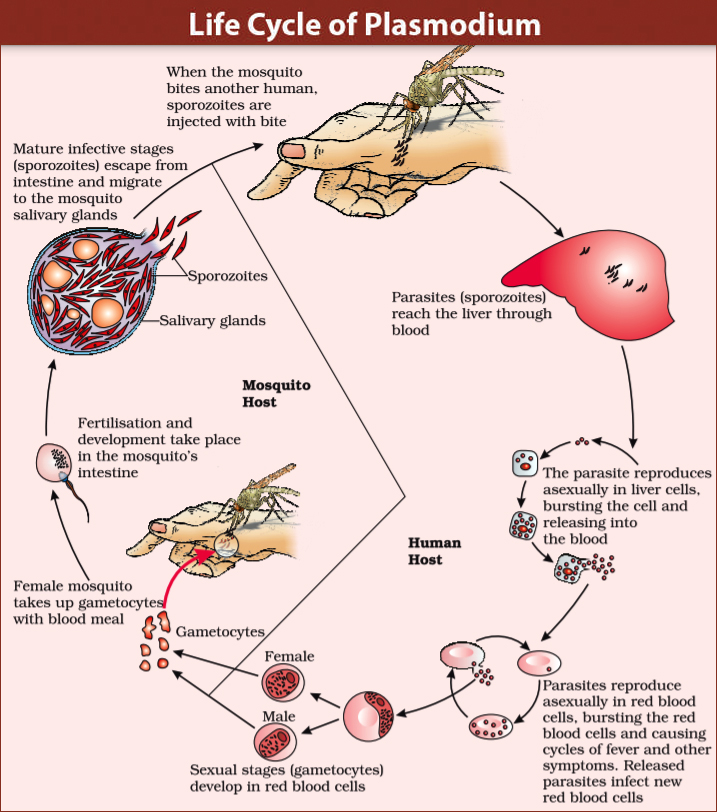Human Health and Diseases
Health
According to World Health Organisation (WHO), health is a state of complete physical, mental and social well-being and not merely the absence of disease or physical fitness. Health is mainly affected by
- Genetic disorders which the child inherits from parents by birth and deficiencies with which a child is born.
- Infections caused by pathogens.
- Lifestyle including the food and water we take, rest and exercise, habits that we have or lack, etc.
Disease
The condition of improper functioning or any condition which interferes with the normal functioning of one or more organ or organ systems of the body and causes disorder of mind or body is called disease. It is characterised by various signs and symptoms.
Types of Diseases
Diseases can be classified as shown below–
1. Congenital diseases– These diseases are present in human since birth (genetic disorders) or are caused due to mutation, e.g. Down’s syndrome, sickle-cell anaemia, etc.
2. Acquired diseases– These diseases develop after birth and are not transferred from parents to offspring.
Acquired diseases are further categorised into
(i) Infectious diseases or Communicable diseases– These diseases are easily transmitted from a diseased person to a healthy person either by direct transmission or by indirect transmission. The infectious diseases are very common, e.g. common cold, etc.
(ii) Non-infectious diseases or Non-communicable diseases– These diseases cannot be transmitted from a diseased person to a healthy person. These diseases occur either due to nutritional deficiencies or malfunctioning of organs, e.g. cancer, diabetes, etc.
Common Infectious Diseases in Humans
Infectious diseases occur either by pathogen which cause disease in human, e.g. bacteria, viruses, fungi, protozoans, helminthes, etc., or by vectors which spread diseases as they act as carriers to transmit the pathogen from an infected person to a healthy person, e.g. female Anopheles mosquito.
Some common diseases and their pathogenic members are discussed as follows
Bacterial Diseases
Some common bacterial diseases are as follows–
1. Typhoid is caused by a bacterium called Salmonella typhi. S. typhi enters the small intestine through contaminated food and water and migrates to other organs through blood.
- Symptoms are high fever (39-40°C), weakness, stomach pain, constipation, headache and loss of appetite. In severe cases, intestinal perforation and death may occur.
- Widal test is the confirmatory test for diagnosis of typhoid.
2. Pneumonia is caused by Streptococcus pneumoniae and Haemophilus influenzae. These bacteria infect alveoli of the lungs. The alveoli get filled with fluid which causes decrease in respiratory efficiency of the lungs.
Pneumonia spreads by inhaling droplets/aerosol from infected individuals, sharing glasses and utensils with an infected person.
Symptoms are fever, chills, cough, headache, etc. In severe cases, the lips and finger nails may turn grey-bluish in colour.
3. Plague is caused by Pasteurella/Yersinia pestis and is also called black death.
4. Diphtheria is caused by Corynebacterium diphtheriae and is characterised by difficulty in breathing due to infection in the mucous membrane of upper respiratory tract.
Viral Diseases
Some common viral diseases are as follows
1. Common cold occurs due to a group of viruses called rhinoviruses. These viruses infect the nose and the respiratory passage, but not the lungs.
The infection occurs when droplets from cough or sneeze of an infected person are either inhaled directly or transmitted through contaminated objects such as pen, books, cups, computer’s keyboard or mouse, etc.
Symptoms include nasal congestion and discharge, sore throat, hoarseness, cough, headache, tiredness, etc., which generally last for 3-7 days.
2. Dengue is caused by Flavivirus and transmitted by Aedes aegypti mosquito bite.
Symptoms are high fever, severe front headache, joint pain, nausea and vomiting.
Treatement for dengue is provided through analgesic medicines as not a vaccine is available for its treatment yet.
Dengue can be prevented by elimination of mosquitoes and their eggs.
3. Chikungunya is caused by chikungunya virus and is transmitted by Aedes aegypti mosquito bite.
Symptoms include onset of fever, crippling joint pain, lymphadenopathy, etc.
Chikungunya can be prevented by elimination of mosquitoes and their eggs.
Protozoan Diseases
Some common protozoan diseases are as follows
1. Malaria is caused by different species of the protozoan. Plasmodium (vivax, malariae and falciparum). Its transmitting agent is female Anopheles mosquito that transfers the sporozoites of Plasmodium.
Different species of Plasmodium (P. vivax, P. malariae and P. falciparum) are responsible for different types of malaria as given below
Plasmodium species Types of malaria
- P. vivax — Benign tertian malaria
- P. falciparum— Malignant/pernicious malaria(Most serious)
- P. malariae— Quartan malaria
- P. ovale— Mild tertian malaria
The life cycle of Plasmodium in its host(s) is described below
(i) Plasmodium enters the human body as sporozoites through the bite of an infected female Anopheles mosquito.
(ii) These sporozoites reach the liver through blood and multiply asexually within the liver cells and attack the Red Blood Cells (RBCs) where they multiply again resulting in their rupture.
(iii) The rupturing of RBCs is associated with the release of a toxin called haemozoin, which is responsible for the high fever recurring every 3/4 days and chill (shivering).
(iv) Gametocytes (sexual stages) develop in the RBCs of human host.
(v) The gametocytes of parasite then enters the mosquito’s body alongwith the blood when female Anopheles mosquito bites the infected person.
(vi) Further development occurs in the stomach wall of the mosquito and the gametes fuse to form a zygote.
(vii) The zygote undergoes further development in the body of the mosquito to form sporozoites.
(viii) These sporozoites are then transported and stored in its salivary glands and are transferred into another human body through saliva.
- Symptoms include influenza like illness, shaking chills, headache, muscle ache, nausea, vomiting and diarrhoea.
- Malaria can also lead to anaemia and jaundice and can also be life-threatening if left untreated.
2. Amoebiasis (amoebic dysentery) is caused by an intestinal endoparasite, Entamoeba histolytica, which is a protozoan parasite of the large intestine of humans.
- Carrier of pathogens is housefly. It transmits the parasite from faeces of an infected person to the food. Infection takes place through the contaminated food and water.
- Symptoms are abdominal pain, constipation, cramps, faeces with excess mucus and blood clots.
Helminthic Diseases
Some common helminthic diseases are as follows
1. Ascariasis is caused by an intestinal endoparasite of human, Ascaris lumbricoides commonly called as roundworm.
- Infection occurs as the eggs of parasite excreted along with faeces of infected person, contaminate water and soil.
- Infection reaches human beings through contaminated vegetables, fruits and water.
- Symptoms are abdominal pain, indigestion, muscular pain, fever, anaemia, nausea, headache and blockage of intestinal passage.
2. Filariasis/Elephantiasis is caused by filarial worms Wuchereria bancrofti and Wuchereria malayi. Culex mosquito (female) is the vector.
- Symptoms are chronic inflammation of organs in which they live, blockage of lymph vessels of lower limbs resulting in swelling. Genital organs also get affected leading to their deformation.
Fungal Disease
- Common fungal disease in humans is ringworm.
- Ringworm is caused by fungi of the genera–Microsporum, Trichophyton and Epidermophyton.
- Infection occurs through contact with an infected person or from soil, through the use of towels, clothes, combs, etc., of an infected person.
- Symptoms are appearance of dry, scaly lesions on various parts of the body such as skin, nails and scalp accompanied by intense itching.
- Heat and moisture help these fungi to grow in regions like folds as in groin or between the toes.
Prevention and Control of Infectious Diseases
- Maintenance of personal and public hygiene is extremely important for prevention and control. Some of the preventive measures that can be taken are as follows
- For personal hygiene Keeping the body clean, consumption of clean drinking water, food, vegetables, fruits, etc.
- For public hygiene Proper disposal of waste and excreta, periodic cleaning and disinfection of water reservoirs, pools, cesspools and tanks and observing standard practices of hygiene in public catering.
- For vector borne diseases such as malaria Eradication of vectors and destroying their breeding sites, e.g. using mosquito nets and repellents, avoiding stagnation of water, regular cleaning of coolers, etc., introducing fishes like Gambusia in ponds that feed on mosquito larvae, spraying of insecticides in ditches, drainage areas and swamps, etc.
- For air-borne diseases Avoid contact with infected persons or their belongings.
- Vaccination and immunisation These programmes for diseases should be strictly followed.



